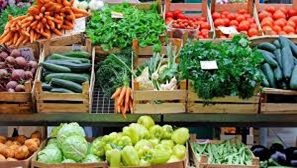
The production of vegetables is very important to Ethiopia’s economy, and various types of vegetables can grow in Ethiopia. Despite the existing potential, smallholder vegetable farms are based on low input– output production systems across the nation.
Keeping this hard fact in mind, The Ethiopian Herald had a short stay with Eshetu Chaka, an agriculturalist graduated from Haramaya University, to collect professional information about vegetable farming in Ethiopia, at what level it is right now and the way forward to help the nation reap the benefit it deserves out of the sub-sector.
He said, “The production of vegetables in the country is most of the time run by smallholder farmers and is located on a relatively small part of land. In the same way, there is inadequate knowledge on improved vegetable production practices, challenges and opportunities for smallholder farmers in the country, and assessment of vegetable crops has been insignificant.”
As to Eshetu, considering practices of vegetable production and management, challenges of vegetable production and management and opportunity of vegetable production by small holder farming household is vital in stepping towards taking sound measures. Vegetable production practices and management are seen as a supplement to the production of major crops mainly based on traditional farming system.”
Lack of access to credit, limited supply of improved seed, marketing and market information, appropriate management techniques, appropriate disease and insect pest control measures, outbreak of new disease and pest are among the main challenges of vegetable production in the country, he added.
Diversified and intensified agricultural farming, and problems related to extension service and research, credit service, disease and pest control, market and marketing information, and provision of modern agricultural inputs should be addressed by concerned bodies for promoting vegetable producer households, he added.
He stated traditional vegetable cultivation in Ethiopia is characterized by smallholder farming, diverse agro-ecological zones, and a reliance on both rain-fed and irrigated systems. Commonly grown vegetables include onions, tomatoes, peppers, kale, and various leafy greens. While production varies from backyard gardening for personal consumption to larger-scale commercial farms, it faces challenges like limited access to improved inputs, post-harvest losses, and market access.
Traditional methods in vegetable cultivation practices are deeply rooted in time-tested agricultural practices and sculpted meticulously by local environmental nuances and age-old cultural traditions in Ethiopia.
To sow vegetables, he said, the ground is laboriously turned, weeds are removed, and any larger clumps are broken down to foster a nurturing environment for burgeoning seedlings. Organic matter, which predominantly decomposed farmyard manure, is meticulously mixed with the soil, he opined.
The very kernel aspects of traditional vegetable cultivation in Ethiopia are the use of smallholder farming. In this way, most vegetable production is carried out by smallholder farmers, often integrating vegetable cultivation with other crops and livestock.
“Agro-ecological diversity is also a decisive element in this regard. Here, Ethiopia’s diverse agro ecological zones, from lowlands to highlands, support a wide range of vegetable crops. The other is a rain-fed and irrigated system. In such a manner, vegetables are cultivated both under rain-fed conditions and through irrigation, with irrigation being more prevalent in areas with suitable water resources,” said Eshetu.
He further stated that over the decades, the evolution of vegetable cultivation techniques has offered a fascinating glimpse into the broader arc of agricultural progression, characterized by technological innovations, deepening scientific insights, and a nuanced understanding of plant biology. Since long back, vegetable cultivation has relied heavily on empirical knowledge passed down through generation.
According to him, there are of course commonly grown vegetable. A wide variety of vegetables are produced, including onions, tomatoes, peppers hot and sweet, Ethiopian mustard/kale, carrots, garlic, cabbage, among others. Besides, many edible leafy greens, such as sweet potato leaves, are also traditionally cultivated and consumed.
Traditional vegetable production faces challenges such as limited access to improved seeds and other inputs, susceptibility to pests and diseases, post-harvest losses due to lack of storage and processing facilities, and inadequate market access.
The Ethiopian government has implemented policies and initiatives to support the vegetable sector, including promoting improved varieties, expanding irrigation, and improving market access so as to solve the aforesaid problems.
Efforts are also underway to strengthen vegetable value chains, connecting farmers to markets and addressing issues like post-harvest handling and storage.
Smart greenhouses, integrating renewable energy sources, advanced climate control systems, and remote management capabilities, have become hallmarks of modern vegetable farming, indeed, he added.
Zehara Muktar is an agriculturalist graduated from Hawassa University. She was approached to highlight the feature of vegetable cultivation in the country.
As to her, vegetables are sources of vitamins, minerals and income for those involved in production and marketing. Focusing on vegetable production and marketing system is essential to devise appropriate strategies aimed at enhancing vegetable value chain development.
Since lack of access to improved variety seeds, high postharvest losses, lack of reliable market information systems, low technological know-how for value chain development have compromised vegetable production, the government needs to increase public awareness the nutritional importance of vegetables with a view to critically help them foster intervention in that regard, she said.
She said, “Ethiopia has a significant vegetable production sector, with both smallholder farmers and commercial farms contributing to the output. The country produces a wide variety of vegetables, including onions, tomatoes, peppers, and various leafy greens. While vegetable production has been growing, challenges remain in terms of inadequate knowledge of improved practices, post-harvest infrastructure, and market access.”
The success of vegetable cultivation is fundamentally anchored in the quality and meticulous selection of seeds, a principle that has been an integral part of agricultural practices throughout history.
As to Zehara, in vegetable cultivation, the convergence of traditional practices and advanced methodologies has been prominently demonstrated in the techniques of hardening, transplantation, and acclimatization.
Considering their diversity nature, a plant may be a vegetable in one country but a fruit, a weed, an ornamental or a medicinal plant in another country, depending on the crop. Various types of vegetable crops are grown in Ethiopia under rain-fed and/or irrigation systems. Increased national and growing regional demand for vegetables has triggered commercial production and boosted private investment in the sector by both national and international entrepreneurs, increased exports to Djibouti, Somalia, South Sudan, the Sudan, the Middle East and European markets, she underlined.
It has been noted that, increasing consumption of vegetables and fruits contributes to reducing hidden hunger i.e. micronutrient deficiency, which is related to health problem caused by a lack of essential vitamins and minerals such as vitamin A, zinc, iron, and iodine in the diet.
“Despite the increasing importance of vegetables in Ethiopia, there is inadequate knowledge on improved production systems and marketing, especially in the humid tropics that was the target area of the present study. With increasing population and declining land size, a better understanding of the production system, marketing channels and endowed opportunities for growth will go a long way to contribute to improve return on investment for value chain actors in the sub-sector.”
She said vegetables are an integral part of the farming system, which plays a crucial role in the economy of Ethiopia. Vegetable production is increasing as a result of increased area allocation as well as increased yield per unit area as well as area put under production.
Much of the increase in production comes from area expansion and an increase in small-scale irrigation activities, enabling two or more production cycles a year. However, productivity at the smallholders’ level is very low compared to yields obtained at research centers. Lack of or limited access to improved seeds, diseases and insect pests, high postharvest losses, and poor marketing systems are the major challenges of the sub-sector.
Expanding irrigation facilities and improving cost efficiency of irrigation water use by improving the irrigation system and increasing public and private sector investment in irrigated vegetable production helps increase the supply of vegetables.
In a nutshell, engaging government and policy makers in frequent dialogues with prime operators in due course of increasing their awareness so as to enhance widespread implementation of vegetable seed certification policy or regulations to support vegetable value chain development, thereby helping farmers get sustainable production, which in turn helps the nation back its national effort towards ensuring food security. In essence, vegetable seed treatments equip seeds for their forthcoming journey, ensuring that they are not only ready but primed for excellence, laying the groundwork for a prolific harvest.
BY MENGESHA AMARE
THE ETHIOPIAN HERALD THURSDAY 24 JULY 2025




